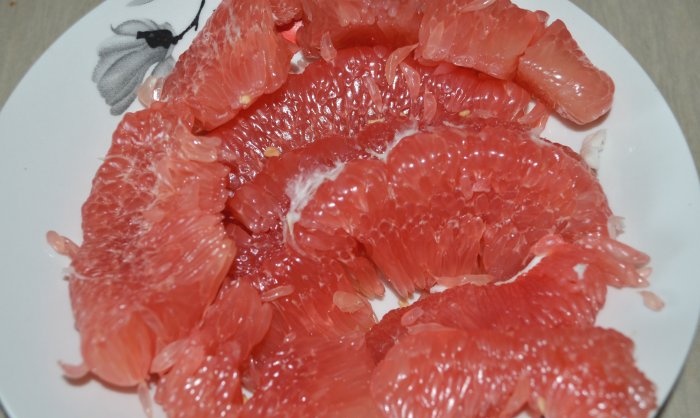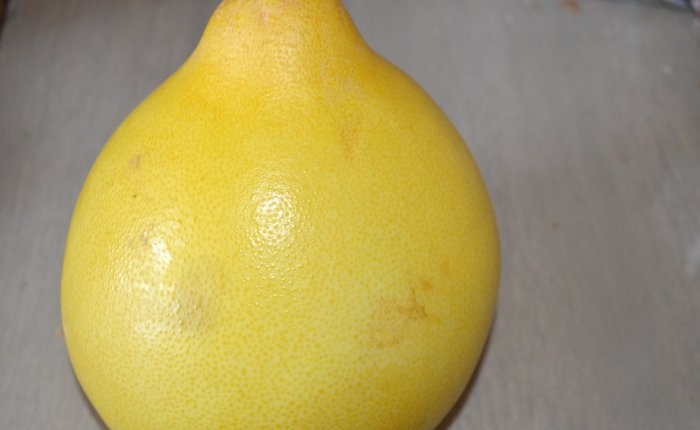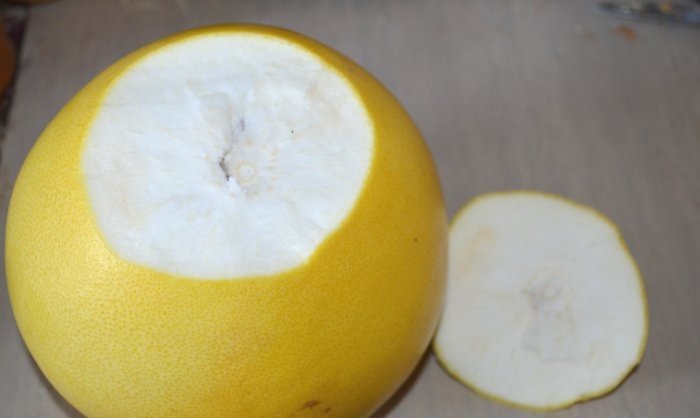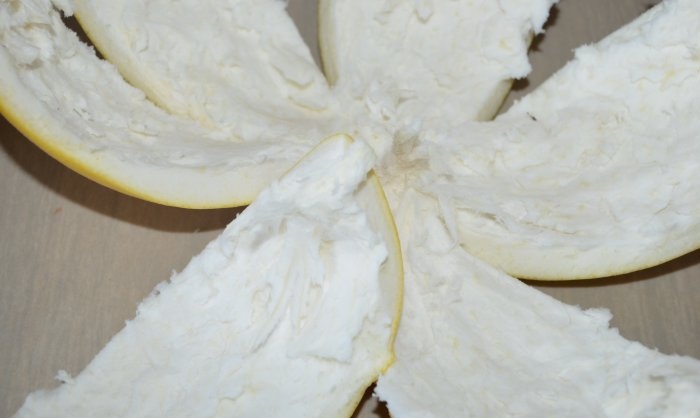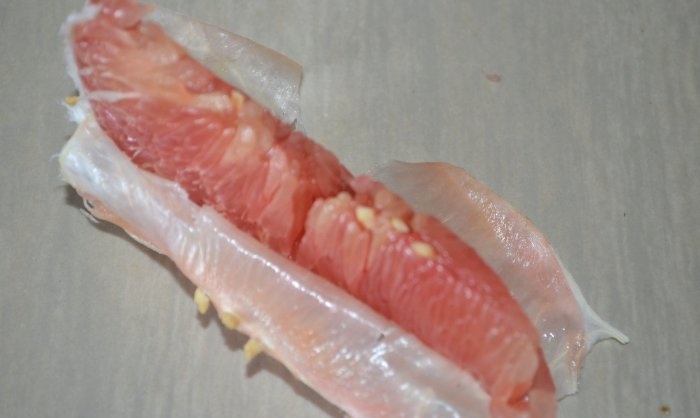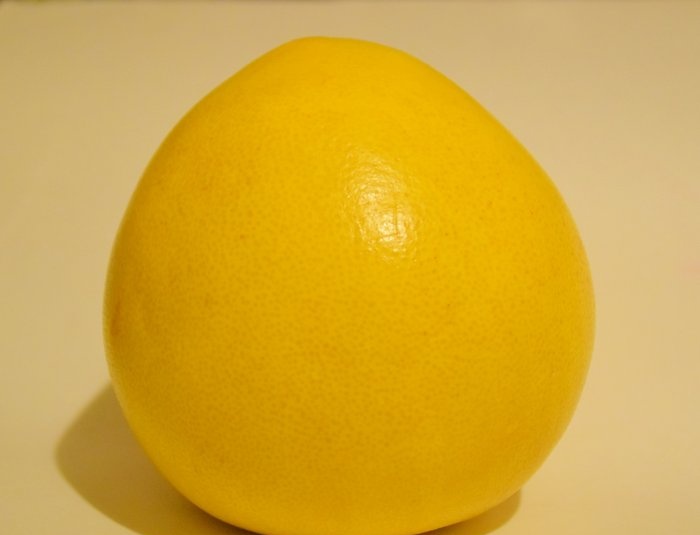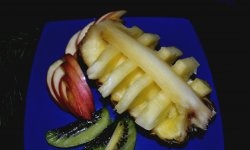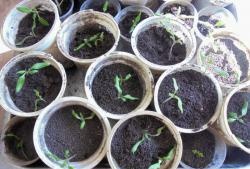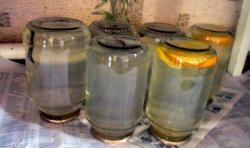Citrus fruits have long ceased to be a deficit in the entire post-Soviet space. Now on the shelves there are not only oranges, lemons and tangerines, but also miniature kumquats and clementines, and huge pomelo.
Given that these citrus fruits appeared on the market about a decade ago, they are still exotic. Even the name is sometimes pronounced incorrectly, with emphasis on the last syllable. Properly pronounce the name of the fruit pomelo with an emphasis on the letter "e".
How to peel pomelo fruit
To enjoy the fruit, you need to properly clean it, for this:
1. The fruit must be washed and dried well.
2. Cut off the top.
3. Make vertical cuts after about 3-4 cm over the entire area of the fruit;
pick up and separate each "petal" of the peel.
4. The peeled fruit is divided into slices.
5. Along the narrow part of the lobule, make an incision and separate the membranes.
6. Put the peeled slices on a plate.
They can be eaten as an independent dish, but can be used to make sauces and salads, because the pomelo does not have a very bright taste and goes well with meat and various vegetables. This fruit will certainly add benefits to the dish.
Fruit pomelo, description
The Russian version of the name of the plant pomelo and its fruits is associated with the English word pomelo, which, in turn, comes from the Dutch words for apple - melon. In addition, the fruit is called sheddock, in memory of the English sailor Sheddock, who in the 17th century brought the seeds of this plant to one of the islands in the Caribbean, and a few years later the plant came to Europe. You can also find the name swollen lemon or large citron.
Pomelo is an evergreen tree from the genus Citrus of the Rutov family. They are quite tall, their height is from 8 to 15 m. The crown is round, the leaves are elongated, dense with elongate stipules. Trees bloom with white large flowers. This occurs two to four times a year. The flowers are white, large. They can be located one at a time or be collected in inflorescences from 2 to 10 pieces. The fruits are large, their diameter can be over 30 cm, and their weight is more than 3.0 kg. If we consider the fruit of the pomelo in the context, then we can distinguish the following parts:
- a colored layer of peel or zest;
- a white, rather thick layer that surrounds the pulp or mezra; it has a pomelo from 10 mm to 30 mm
- thin, transparent film membranes that divide the flesh into segments;
- juicy cells under membranes or pulp.
The first mention of the plant dates back to the 1st century BC and is associated with China, where the fruit was pomelo served to the imperial table. No wild ancestor of this plant was found. Most likely, hybridization occurred by chance and a very long time ago.
Gradually, the plant spread to southern and southeast Asia. Currently, pomelo are grown in China, Thailand, South Africa, Brazil, the southern United States, Israel and Japan. There are several varieties of this fruit, they are characterized by a form:
- pear-shaped;
- spherical;
- spherical, oblate.
The skin color is most often yellow-green or green, there are fruits with a pink blush. The pulp may be light yellow or pink. The taste is not very bright sweet, sweet and sour, there may be a slight bitterness. In order not to spoil the first impression of the fruit, the pomelo must not only be correctly selected, but also properly cleaned.
How to choose and peel pomelo fruit
Pomelo fruit selection
When choosing a pomelo, you need to know that the harvest of this fruit begins in December and ends in March. The peak of the season falls on February, therefore, the highest quality and freshest fruits appear on the shelves precisely in these months.
When buying, you need to pay attention to the size of the fetus. It is not necessary to acquire extremely large fruits, but also small ones can be ignored. It is advisable to buy a fruit weighing from 1 to 2 kg.
The skin of the fetus should be smooth, with no signs of rot and dark spots. In some varieties, some wrinkling of the skin during prolonged storage is permissible. Most often, the fruits are sold in film or in a net. This does not hurt to feel them. They should not be too soft or hard. When pressed at the top, the fruit should be resilient. If you smell the fruit, then a pretty pleasant smell should come from it. If the selected fruit meets the above description, then it can be safely purchased.
The benefits and harms of the fruit pomelo
The main benefits of pomelo fruit are high in vitamin C and low calorie content. It is enough to eat 120-130 g of pulp of this fruit to satisfy the daily requirement of an adult in this vitamin. There are also vitamins of group B, A, E. in this fruit.
The calorie content of 100 g pomelo does not exceed 38 kcal, this makes it possible to use the fruit in low-calorie diets. The use of this citrus may be recommended for patients with diabetes mellitus. It perfectly cleanses blood vessels, lowers cholesterol. It is useful to eat a pomelo:
- to strengthen immunity;
- for the prevention of strokes and heart attacks;
- to reduce body weight.
- to reduce the risk of thrombosis and atherosclerosis.
It is harmful to eat pomelo fruit for people with allergies, with acute diseases of the liver, kidneys, gastrointestinal tract.
